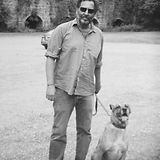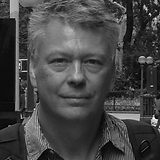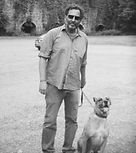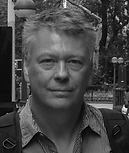For production designers, the transition from creating work to observing it on screen can trigger complex responses. Our colleagues discuss their reactions and observations as their own audience.

Lester Cohen
"There is a distinction to be made between early viewings and seeing something months, and then years later."

Darcy Scanlin
"There is no going back; what is done is done, burned into that film...forever."

Brad Ricker
"Making a film is like pushing a boulder up a hill, and when you finally see the film you see it resting at the top on level ground."

Melinda Doring
"I became aware how all the planning had created a great collaborative environment."
March 7th, 2020
How do you feel watching your work on screen?

Lester Cohen
Lester Cohen is a New-York based production designer. Among his credits are the films "Dogfight", "Copland" and "The Assassination of Richard Nixon". His TV credits include: "The Night Of", "White Collar" and "The Looming Tower".
There is a distinction to be made between early viewings and seeing something months, and then years later.
My first glimpse of my work is most often a late-night laptop viewing of dailies. Dailies are typically a painful experience for me. I question everything, the coverage, color choices, composition, all of the objects in the frame, aging etc…noting all of my mistakes. Often all I can see are the errors. Then begins the contemplation on how to correct the things that can be remedied, and how to minimize the things that cannot. I do miss projected dailies, as they were much more informative. I have fond memories of the crew, battered by a long day of shooting, piling into the Du-Art screening room and sharing each other’s hard work over a cold beer and not so warm pizza. What I loved was how it brought all the departments together and how it fostered both ownership and pride in the work. In those days, filmmaking retained a bit of alchemy… No video village. We’d set up the shot, the director would be perched on an apple box close to the lens and as close to the actors as possible. Silver nitrate being exposed to light 24 times a second, and then the magic of seeing it transformed into an image 20 ft tall the following evening.
The next time I see my work is often at an early screening of a rough cut. By that time, I am
usually on another project and most of my wounds have healed. If I’m lucky the story is actually
working, and our efforts to help build a particular world have been effective. Usually, I am still too
close to the work to completely relax and enjoy it.
My favorite time to see my work is years later. I often stumble upon a film while channel surfing
late at night. By then all of the behind the scenes difficulties are long forgotten and I can
appreciate the film as a cohesive entity.

Brad Ricker
Brad Ricker began drawing strange characters with highly detailed backgrounds in pen and ink in high school in Massachusetts. He studied film, photography, architecture, fine arts and semiotics in Rhode Island and Paris. He worked in New York on small films and Spanish language commercials. He worked in Los Angeles on extraordinarily imaginative movies with massive set construction. He now travels widely to work as a Supervising Art Director or
Production Designer on projects big or small, great or good, fun or ...challenging.
When a movie is finally released, I get invited to the Cast and Crew screening and ten months of my life flies by in two hours. It can be a white-knuckle experience. It’s exhilarating, whether the movie is great, or less than. I always see moments that shine. I am surprised by how much I like any film I have worked on. I come out happy, and amazed, and tell my fellow crew members how much I enjoyed it. I’m surprised if they feel the opposite or express disappointment. Was I expecting too little? Were they expecting too much?
Then I remember - I’m the one who spent the beginning of the film skeptical, worried that the film’s potential would not be realized, that deadlines would be missed, moments of drama fail, VFX look bizarre, or things that were never supposed to be shot, get featured prominently. But those fears were unnecessary, everything kind of works. Amazing. Two things I realize anew at the screening - the lines are being said by highly attractive people, and, movies can cut all the boring parts of life out. Then I also realize- there is some wonderful set that is missing... the scene is gone. But if the film is good, you only think about that the next day.
When a movie makes too much of a set, for instance shows a character walking into it and saying “Wow!...” you would think that would make a designer happy. It is the kiss of death. It shows that the drama isn’t there on the page and they need to lean on the scenery. When the scenery is taken for granted it seems most real. Fleeting images, out of focus, hurried-through sets used to bother me. I always wanted a big master shot to show them fully. Well, I still do sometimes, I guess, when it’s not obvious; maybe established at just the right moment without dwelling too long there. A hungry camera is more interesting. Better to use the sets eagerly than to show them off.
Making a film is like pushing a boulder up a hill, and when you finally see the film you see it resting at the top on level ground. I’m always amazed it got there, because so much has to come together after we finish our work. We push it up halfway. And we start without a path on rocky ground and point it in a direction. Always uphill. Watching the finished film you get to the actual peak you never saw before, but made the map to, and believed was there.

Darcy Scanlin
Darcy Scanlin has over 20 years experience as a production designer for feature films, live events, commercials, music videos, theater and opera. Her most recent feature was "Uncle Frank", directed by Alan Ball, which premiered at Sundance 2020. She also designs live events, working with Little Cinema, Warner Media, TNT HBO and SAG, and most recently designed the red carpet for the SAG Awards. She has worked with theater companies such as the Prague National Theatre, BAM, Bard Summerscape, Long Beach Opera, South Coast Repertory, A Noise Within, The Getty Center and many others.
Performing was one of my favorite things to do while growing up, from childhood all the way through college; I was in over 30 musicals as a kid and went on to sing opera in college. My life has always revolved around shows. My mom is a visual artist and she designed all of the sets and we painted them together for many of the productions I was in growing up. So working behind the scenes was just built into my DNA, it was part of life. But when it came to performing, while I absolutely loved it, lived for it and found it utterly exhilarating, I dealt with serious stage fright. Ever since I can remember and through my early 20's, I dealt with extreme nervousness, sweaty palms, and a heart that pounded so hard I could visibly see my shirt moving. There were times in college, during operatic auditions and competitions, my nerves were so intense my throat would just close up.
As a production designer now, watching my work on screen is very similar to performing, but only in the best way. It feels thrilling and exhilarating in the same way, but without all of the dread and horror of stage fright. Unlike performing, I rarely feel nervous watching my work, because I work so hard to get it right, believe thoroughly in the work, and there is no going back; what is done is done, burned into that film...forever.
Robert Israel taught a masterclass when I was in grad school at CalArts, and I remember him asking us students, "Why do you design?" He suggested, "We design in order to extend our mortality." Honestly, the experience of watching my work on screen is profoundly moving, as if I'm registering my identity with the future and with history. It is as if I have created something that will live on well past my life time.
I recently designed "Uncle Frank", written and directed by Alan Ball. It was an incredibly special film, made by a crew that cared deeply about the project and literally poured every bleeding ounce of their hearts into it. We shot it in Wilmington, NC. last summer (2019). The film premiered at Sundance last February, and seeing the film was intense; I watched in a sort wonderful shock, awe and tears. I was a complete mess! But it was amazing.
When you work with thousands of details - so many locations and parts so disconnected throughout the design process - and then see it all come together into one unified whole, the revelation of your vision expanding the power of the story - so fragmented for so long - is utterly magical. It's like watching a jigsaw puzzle turn into a real person. Fifteen years in, I am still in awe of basic movie magic; how the interiors we build match separate exteriors on location. I am still fascinated by how the sets we create really achieve a sense of time travel, character and emotion - and tell their own story. I am still amazed at the genius of actors and how they turn words on a page into drama that can move one to tears.
Watching my work on screen is one of the most satisfying, surprising and powerful experiences I know. And it reminds me that it's not just my work, it's the power of collaboration and cooperation - how every person on the team, cast and crew, makes ten thousand decisions that somehow come together in a grand synthesis that transforms a script into an amazing story.

Melinda Doring
Melinda Doring has designed a number of highly regarded Australian feature films and television projects, including "The Sapphires", "Summersault", "Berlin Syndrome", "Palm Beach" and "The Home Song Stories".
Watching anything I have worked on for the first time is a challenge. You always wonder how much you can disconnect yourself from working on the project as if you had never read the script or experienced the process of making the show.
This year a TV series I worked on last year called "Stateless" was invited to screen as part of Berlinale Series. The first two out six episodes were screened at a glittering red-carpet event.
It was incredible to watch the episodes with an international audience on a big screen. Watching it in this way was slightly nerve-racking as the show was made for television and you hope that it will translate well for the bigger screen and be an immersive cinematic experience.
With Stateless it was exciting to watch the first episode as it sets up so much of the premise for the series and introduces us to a variety of very different characters and worlds. It was interesting to see our colour palette choices - that were made to give some specific sequences a unique look - come together between costume and set decoration.
Watching the Australian desert location on the big screen whilst in Berlin made me aware of the extreme difference of our dry dusty environment compared to that of a cold European winter. Seeing the largest set we created - a detention centre - be revealed was exciting. I think the producers took a risk approving building our set on location. This choice really paid off, as the location really gave the show some scale and authenticity, and there is something quite poetic and desolate about this large prison environment placed on the edge of the desert.
What I was really struck with was the scenes we shot in Timor – this was the last thing we filmed on the show in September last year. It was a solution that was presented to us at the last minute and with very little pre-production and it was an exhausting part of the shoot. The end result was so exciting. Timor as a country is so unique to see on screen – it really was a great outcome for us shooting in this country and added so much colour, contrast, and texture to the show.
One thing I was slightly nervous about was the high definition shooting style – seeing so much more detail on the big screen compared to the average TV screen, I became very aware of things like grit, sweat and dirt which was present on the actors faces – so I think the make-up department and costume department did a great job making everyone fit in with the desert environment, and made the audience feel the heat of the shooting environment.
I think the choices made in locations really worked and I was glad that myself and my collaborators were on the same page when choosing these locations - as the contrast between the different character worlds really helped with the story telling.
Sometimes it is not easy disconnecting from the experience of making a project and appreciating watching a project for what it is. However, what I really noticed watching this screening, was just how good the scripts had been. I also became aware how all the planning had created a great collaborative environment for producing the show. From the cinematographer to the costume and the make-up department everyone was on the same page. So, the passion for this timely international story really came through in the end result.
